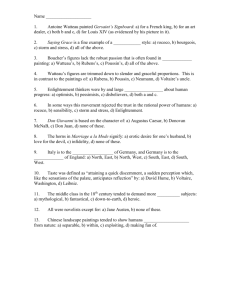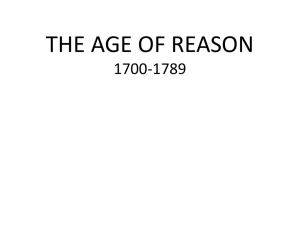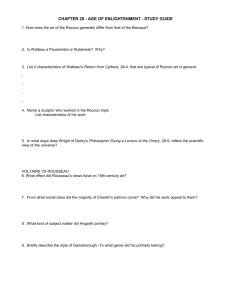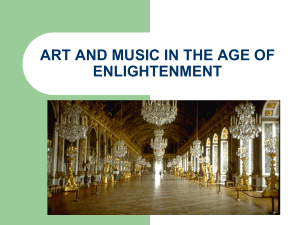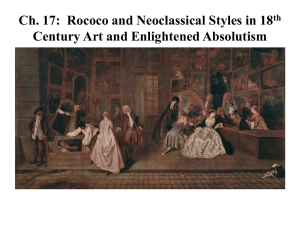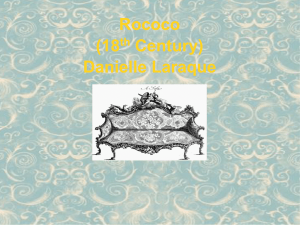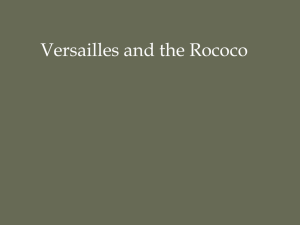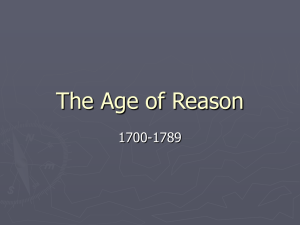1700s---Rococo and Neo-Classical (18 th century)
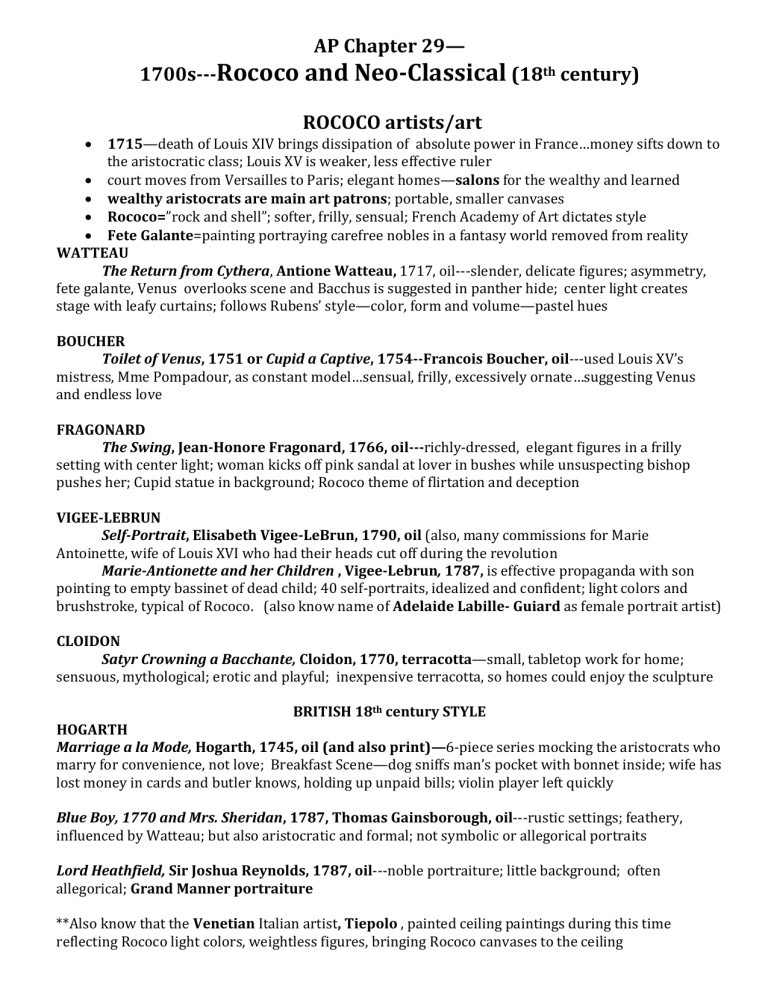
1700s---
AP Chapter 29—
Rococo and Neo-Classical
(18
th
century)
ROCOCO artists/art
1715—death of Louis XIV brings dissipation of absolute power in France…money sifts down to the aristocratic class; Louis XV is weaker, less effective ruler
court moves from Versailles to Paris; elegant homes—salons for the wealthy and learned
wealthy aristocrats are main art patrons; portable, smaller canvases
Rococo=”rock and shell”; softer, frilly, sensual; French Academy of Art dictates style
Fete Galante=painting portraying carefree nobles in a fantasy world removed from reality
WATTEAU
The Return from Cythera, Antione Watteau, 1717, oil---slender, delicate figures; asymmetry, fete galante, Venus overlooks scene and Bacchus is suggested in panther hide; center light creates stage with leafy curtains; follows Rubens’ style—color, form and volume—pastel hues
BOUCHER
Toilet of Venus, 1751 or Cupid a Captive, 1754--Francois Boucher, oil---used Louis XV’s mistress, Mme Pompadour, as constant model…sensual, frilly, excessively ornate…suggesting Venus and endless love
FRAGONARD
The Swing, Jean-Honore Fragonard, 1766, oil---richly-dressed, elegant figures in a frilly setting with center light; woman kicks off pink sandal at lover in bushes while unsuspecting bishop pushes her; Cupid statue in background; Rococo theme of flirtation and deception
VIGEE-LEBRUN
Self-Portrait, Elisabeth Vigee-LeBrun, 1790, oil (also, many commissions for Marie
Antoinette, wife of Louis XVI who had their heads cut off during the revolution
Marie-Antionette and her Children , Vigee-Lebrun, 1787, is effective propaganda with son pointing to empty bassinet of dead child; 40 self-portraits, idealized and confident; light colors and brushstroke, typical of Rococo. (also know name of Adelaide Labille- Guiard as female portrait artist)
CLOIDON
Satyr Crowning a Bacchante, Cloidon, 1770, terracotta—small, tabletop work for home; sensuous, mythological; erotic and playful; inexpensive terracotta, so homes could enjoy the sculpture
BRITISH 18 th century STYLE
HOGARTH
Marriage a la Mode, Hogarth, 1745, oil (and also print)—6-piece series mocking the aristocrats who marry for convenience, not love; Breakfast Scene—dog sniffs man’s pocket with bonnet inside; wife has lost money in cards and butler knows, holding up unpaid bills; violin player left quickly
Blue Boy, 1770 and Mrs. Sheridan, 1787, Thomas Gainsborough, oil---rustic settings; feathery, influenced by Watteau; but also aristocratic and formal; not symbolic or allegorical portraits
Lord Heathfield, Sir Joshua Reynolds, 1787, oil---noble portraiture; little background; often allegorical; Grand Manner portraiture
**Also know that the Venetian Italian artist, Tiepolo , painted ceiling paintings during this time reflecting Rococo light colors, weightless figures, bringing Rococo canvases to the ceiling
NEO-CLASSICAL artists/art (1760-1820)
The Enlightenment evolves as societies turn from feudalism to search for equality among classes. Rejects royal and aristocratic authority. Revolution.
Democratic principles look to classical ideals and art of Greece and Rome
Pompeii unearthed, 1748, and in response, Winkelman writes first art history book, 1764
Diderot, first encyclopedia, 1764 ---follows Enlightenment belief that all social problems can be solved with knowledge. Samuel Johnson, first English dictionary, 1755
Voltaire=”knowledge saves man” . Rational. Against despots, church, kings and old regime of control.
Rousseau---simple naïveté and goodness saves man. Naturalism aligns with revolutionary principles of dignity in “noble simplicity”
Industrial Revolution=march to “progress”; but increased mechanization also creates
inhumane conditions for workers ; Manifest Destiny = expansion of colonialism for progress
1779-First cast iron bridge built (Coalbrookedale, England, Darby and Pritchard); Roman arches, brittle property of cast iron relieved by lattice design
REVOLUTIONS: 1776 (USA vs Britain) and 1789 (France)
Grand Tours for cultured young scholars, touring Italy for education in the classics
Exemplum virtitus=noble paintings implying self-sacrifice for the social good (eg: David’s Oath
of the Horatii)
CHARDIN
Bridges gap between Rococo and Neo-Classical. Reaction against aristocracy in France; return to simplicity and morality in paintings; reflects Enlightenment values and Naturalistic philosophy.
Dignity in simple life and goodness (often depicted through mothers and children).
WEST
Death of Gen. Wolfe, Benjamin West, 1771, oil—West is American, but painted for British; shows battle of Quebec where Brits beat the French; Gen. Wolfe is heroic, in saintly pose at death, like Mich.’s
Pieta or Hellenistic Dying Gaul (masked unbecoming features); Protestantism over Catholicism; figures and clothing are contemp. ; like a triptych with triangular groupings
KAUFFMANN
Cornelia Pointing to her Children as Treasures; Angelica Kauffmann; 1785, oil---Swiss, lived in
England primarily; Roman history theme of Cornelia, mother of sons who will be political leaders; triangular composition, simple, classical background, classical clothing. Exemplum virtutis.
DAVID
Oath of the Horatii, 1785—(right before French Revolution)--grand ideas of classical nobility…honor for country over personal tragedy. Women reflect loss ( intermarriages); 3 Roman brothers pledge war against Alba----to father; heroic stance, groups of three: 3 doric arches as frames, 3 swords. Oddly, though, patron was French king.
Death of Marat, 1793---Revolutionary times; David supported Reign of Terror and decision to execute king; Marat is a martyr, killed by royalist Charlotte Corday ; David ignores disfiguration by skin disease and portrays Marat in Christlike (Pieta) pose, letter of money support to a soldier’s widow. Although
Neo-Classical, has dramatic lighting like Caravaggio
Napoleon, (many, including at National Gallery in DC). David is arrested and imprisoned in 1794 as a revolutionary, but escapes death and is commissioned by Napoleon to paint noble , heroic portraits.
NEO-CLASICAL SCULPTURE
HOUDON
Bust of Ben Franklin, Bust of Voltaire, bust of Washington---greatest portrait sculptor of neoclassical; very realistic (but with togas!). Compare Houdon’s busts with Bernini’s Baroque bust of
Louis XVI. Both Bernini’s and Houdon’s busts show insight into the personality of the subject, eg: humor and sarcasm of Voltaire, imperious command of king, but dressed differently---toga vs royal robes. Washington, 1792, has plow and sword indicating return to farming (which was short-lived, as he then became president)
CANOVA
Cupid and Psyche, 1787-93 (now at the Louvre)---extremely smooth texture; nude, sensual; multiple views and negative space; mythological subject
Pauline Borghese as Venus, 1808, Rome---Napoleon’s sister as Venus; sister is noted for her sexual energy and few people allowed to see sculpture; fine white marble, as people thought classical sculpture once was…pure and without paint
GREENOUGH
George Washington, 1840---now in entrance to Smithsonian Museum of American History---goofy toga; god-like posture; originally for the Capitol, but rejected, as the Neo-Classical style was going out of favor by mid-1800s.
NEO-CLASSICAL ARCHITECTURE
Cast-iron begins to influence architecture (Coalbrookedale Bridge in England, 1779, is first major cast iron structure. Still standing).
But Classicists still think stone is best as it reflects ancient classical structures. Great buildings of the
Federalist style in America (as in Europe) are symmetrical, balanced, domed, with rectangular rooms.
The White House reflects this classical style with each room decorated in different themes…eg: green room, red room.
BOYLE and KENT
Chiswick House, 1725, London---influence of Palladio’s Villa Rotunda with: statue of Palladio on grounds; low dome; pediments over windows and doors, rusticated, exposed basement ground level; symmetrical façade; white stone surface with no ornamentation. Not like Palladio: with large, semicircular dome windows; obelisk-like chimneys. Like Inigo Jones’ Banqueting Hall, 100 years earlier. Was not residence but pavilion to show art work.
JEFFERSON
Monticello (built—1790-1806)
By Thomas Jefferson, in Virginia. Strong classical references (like Pantheon and Palladio’s Villa
Rotunda that Jefferson had never seen but had studied). Front, Doric- columned porch and 8-sided dome drum. Symmetrical wings like Villa Rotunda
Virginia State Capitol ---studied Roman ruins in Nimes, France; and Temple Portunus in Rome. Ionic portico, pediment and classical proportions. Dignified. Called Federal style in America.

